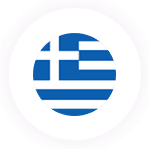Humans set up agricultural and seafaring societies in the Netherlands dating back over six millennial. Like other tribal people of Northern Europe before the Common Era, farmers made tools first from stone, then bronze and finally iron marking the progression of the ages. In the first century B.C. Julius Caesar conquered Gaul which included present day Belgium and southern Netherlands and these lands became part of the Roman Empire. The Romans served to civilize these ancient Germanic tribes and from them were borne two primary Germanic peoples: the Franks and the Frisians (Frisian is a West Germanic dialect of modern Dutch). The Romans stuck around for another four hundred years but were eventually forced to withdrawal as they saw their own Empire begin to crumble and collapse (Rome was sacked by the Visigoths in 410). After the Romans left, the Netherlands and Belgium were populated with three Germanic tribes: the Franks (precursor to the French); the Saxons (precursor to the English) and the Frisians (Dutch). The Franks eventually triumphed as the master tribe and reigned over the region with domination. The modern Dutch language is derived from the Franks and so (like English) is a Germanic language. The French language would later evolve as an Italic or Latin-based language.
Christianity was introduced to the region in the 8th century by Irish and Scottish monks and Anglo-Saxon missionaries. Saint Boniface is the English missionary most famous for spreading Christian beliefs throughout the Frankish Empire; in fact, he was killed (and thus martyred) by some local Frisians in what is now called the Netherlands in 754. A few decades later Charlemagne (aka Charles the Great) became King of the Franks and Emperor of the Romans. The Frankish Empire would greatly expand under the ambitious Charlemagne, adding northwestern Germany (modern day Netherlands and Belgium) under his control. The Netherlands were cut up into administrative divisions ruled by counts. After Charlemagne’s death in the early 9th century, his huge empire was split into three parts: France, Germany and everything in the middle. At first, the Netherlands was part of the Middle Empire, but by the early 10th century it became part of the German Empire. During this period, as with the British Isles, the Netherlands became susceptible to Viking raids. As the Middle Ages were in full swing, the various provinces of modern day Belgium and the Netherlands were often at odds, but they managed to work together and build towns which flourished in trade relations.
A small civil war broke out in Holland in the 15th century as the capitalistic bourgeois class struggled against the ruling nobility. The last Countess of Holland was defeated and the Dutch-speaking territories were assumed by the Duke of Burgundy. The “Low Countries” (so named for the low lying region of several river deltas covering Belgium, the Netherlands, Luxembourg and parts of northern France and western Germany) became one of the many possessions of the powerful Hapsburg Empire ruled by the Spanish branch of this vast monarchy. During the Reformation of the 16th century, a revolt against Spain was orchestrated by the Calvinist-convert William of Orange who set off the Eighty Years’ War against Spanish rule and religious persecution. William the Silent (as he was also known) became a champion of the Dutch people and a defender of freedom. The Eighty Years’ War ensued with bloody consequences. Even though the Dutch people courageously united in rebellion, the Spanish were a formidable enemy. Eventually they would assassinate William of Orange in 1584. Protestant England intervened with assistance much to the chagrin of Catholic Spain. The War was finally ended by Spain’s recognition of the Netherlands as an independent republic in 1648. But before becoming an independent nation, the Netherlands had already formed the prosperous trading companies Dutch East India and Dutch West India. They also established the colony New Amsterdam (i.e., New York) in North America (1625) and another colony in South Africa. The budding Dutch navy (which had already once defeated the fearsome Spanish Armada) was voyaging far and wide. The Dutchmen William Jansz and Abel Tasman were the first to discover Australia (1606) and Tasmania (1642), respectively. Amsterdam was probably the single most important trade city in northern Europe, and the Dutch were unusually tolerant of all religions (of course partial to Protestantism and all of its sects). For such a teeny-tiny country by today’s standards, the Dutch certainly were able to accomplish a lot in the seventeenth century!
Trade rivalries reached boiling points with England, and so the two countries often found themselves at war several times in the 17th century. A peaceful union was formed when another William of Orange (ruler of the Netherlands) married the English Princess Mary Stuart. William and Mary would eventually become co-monarchs of England, Scotland and Ireland in 1688. Imagine that. A Dutch ruler of England. Well, he really obtained the British monarchy through the succession of his wife who happened to be the daughter of pro-Catholic and pro-French King James II of England. William III was safely Protestant and Parliament-friendly, so we was welcome by the elite. Back in the Netherlands, the arts and sciences were thriving. Rembrandt van Rijn (1606-1669) and Johannes Vermeer (1632-1675) were painting; Baruch de Spinoza (1632-1677) was philosophizing; and Olivier van Noort was circumnavigating the world (1598). Not to mention scientists, mathematicians, inventors and astronomers. As we all know, freedom paves the way for innovation.
The Netherlands would lose much of their economic and global power starting in the 18th century. They were substantially weakened by the War of the Spanish Succession (1701-1714) after which England and France would emerge as the primary European trading powers. At the end of the century, the French Revolution pretty much threw all of Europe into a tailspin. Napoleon invaded the Netherlands and absorbed it into the French Empire. After Napoleon was defeated at Waterloo (present day Belgium) in 1813, the Netherlands were joined with Belgium to form one country under King William I. The Belgians weren’t too happy with this outcome, and so they rebelled until they received their independence. King William’s successor, his son William II, instituted a new liberal constitution and the rest of the 1800s were marked by stability and economic prosperity as the Netherlands transformed into a modern industrialized society. The 19th century also produced the great Dutch painter Vincent Van Gogh.
In the 20th century, the Dutch maintained a policy of neutrality with Germany in both the World Wars. In both cases, this would backfire. In WWI stress on their resources caused food shortages and riots. They also suffered from the worldwide Great Depression after the Great War more so than other European countries. They again remained neutral when the Second World War broke out; this time the Germans rewarded them by invading their country and bombing the city of Rotterdam. Thousands were involuntarily deported to work the war effort in Germany; those who resisted were systematically killed. The Germans also stole all their food and left the Dutch people to starve for themselves. More than 80% of the 140,000 Jews living in the Netherlands were murdered. The Dutch people still seem to harbor much resentment toward the Germans for the horrible suffering inflicted upon them more than 60 years ago.
The latter half of the 20th century saw slow but steady recovery. In 1949 the Dutch colony of Indonesia became independent, followed by Suriname in 1975. In 1957 the Netherlands was a founding member of the EU and adopted the euro in 1999. Today the population of the Netherlands is around 16 million and flower-growing remains a prosperous industry. You might say their flowers still stand proud and tall.
Now that you know a little bit about their history, let’s discuss Dutch personal naming habits. Given the region’s early beginnings, it’s probably no surprise that Germanic names dominated from antiquity up through the early Middle Ages. Germanic names are generally comprised of two elements. Take William for instance, or Wilhelm in German (Dutch: Willem). The Germanic “wil” means “desire” and “helm” means “helmet, protection”. Adalheidis (Adelaide) comes from the Germanic elements “adal” meaning “noble” and “heid” meaning “kind, sort, type”. The components of Adalbert (Albert) mean “nobel” and “bright, shining” and for Gertrud it’s “spear” and “strength”. Germanic names dating back to antiquity refected the values important to the various pagan tribal people: battles, warriors, strength, valor, nobility, etc.
Things changed with the introduction of Christianity in the early Middle Ages. At this point in time, names became primarily influenced by the Catholic calendar of saints (most of which were Latin-based names or foreign in some way to the Dutch mother tongue). Christian names rapidly became more popular than Germanic names and by the 1100s, naming children after saints became the de facto custom. Once de facto, it became the prevailing trend. It wasn’t that Germanic names disappeared; they just became the small minority. We cannot underscore the direct influence the Church had on all of Western Europe when it came to naming children. Veneration of saints was more than widespread in precarious medieval times – it was a form of spiritual protection one was placing one one’s child. Saints were admired and loved for their religious fortitude, miraculous legends and for their patronages. Parents didn’t just want to protect their children; they also wanted to assist them in their futures. If a child was born into a family of carpenters, he might be called Jozef (Joseph) the patron saint of carpenters, Joris (George) for a family of butchers, or Luuk (Lucas) for physicians.
Like many other cultures, the Dutch also developed naming traditions around rules of birth order and using relatives as namesakes (e.g., the first son would be named after his paternal grandfather and the first daughter after her maternal grandmother). The Dutch had some superstitious beliefs tied up in this practice that distinguishes them from their other European brethren. Apparently it helped an older relative with their reincarnation prospects.
What’s interesting about the Dutch today is that they are one of the more secular and non-religious of nations. Most believe in God or some sort of spiritual force, but they aren’t big on church-going or affiliating themselves with a particular institutionalized religious doctrine. Catholicism is still the largest religion (28% of the population) followed by Protestantism (the Dutch Reformed Church or Calvinism) with 16% followers. As you can imagine, names based in the Christian tradition don’t hold the same value but they are still widely used since they’ve been around so long! The Dutch are just a little bit more open to playing around with names, adopting foreign names, or sounding out names they simply like. Dutch children are often given more than one name (Catholics for instance still include a baptismal name and often use Latin names; Protestants opt for simpler Dutch names).
Another distinguishing feature of the Dutch naming traditions is the plethora of pet forms which developed from all Germanic and Christian names. Considering the small size of this country, they have a remarkable assortment of localized variations of personal names. Some interesting examples include variations of William (Willem, Jelle, Pim, Wil, Willy, Wim) or Elizabeth (Betje, Elsje, Isa, Lies, Liesbeth, Liese, Liesje, Lijsbeth, Lisa). Lieke is used for Angelique; Stijn for Constantine; and Daan for Daniel.
The five most popular male names in the Netherlands in 2011 were: Daan, Sem, Milan, Levi and Luuk. Also on their Top 10 list is Jayden, which they borrowed from Americans. For little Dutch baby girls in 2011, the five most popular names were Emma, Julia, Sophie, Lotte and Isa. Notice the first three names are Ï‹ber-popular in America as well.
P.S. We should also mention that many people refer to the Netherlands as Holland, when in fact Holland (north and south) are provinces of the Netherlands. Holland is where you’d go to visit Amsterdam, Rotterdam and The Hague. Dutch people from the other regions of the Dutch Republic would probably appreciate you not referring to the whole of their country as simply Holland.










